 Thursday, June 10, 1999, Deer River, Minnesota -
If the entire world economy were to slip into a coma this January, when computers may try to add 100 years to all our lives, when huge ships may just tip right over, and beanie babies may become the official U.S. currency, Gil Quaal will survive, for he can survive on Mother Earth and the fruits she bears naturally. In fact, Quaal can survive in the deep woods with only a handful of ferns, a pocketful of mushrooms and maybe a perch fetched from a nearby river. He can feed himself and others, and he has done this - survived on only foods gathered from the wild - for months at a time, and he is still alive to tell about it.
Thursday, June 10, 1999, Deer River, Minnesota -
If the entire world economy were to slip into a coma this January, when computers may try to add 100 years to all our lives, when huge ships may just tip right over, and beanie babies may become the official U.S. currency, Gil Quaal will survive, for he can survive on Mother Earth and the fruits she bears naturally. In fact, Quaal can survive in the deep woods with only a handful of ferns, a pocketful of mushrooms and maybe a perch fetched from a nearby river. He can feed himself and others, and he has done this - survived on only foods gathered from the wild - for months at a time, and he is still alive to tell about it.
It's Wild!
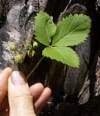 Strawberries - "Should be ready in a week or two."
Strawberries - "Should be ready in a week or two."
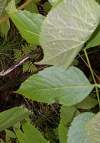 Spikenard - Abundant in Minnesota, and you can eat it raw.
Spikenard - Abundant in Minnesota, and you can eat it raw.
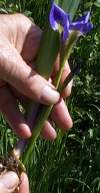 Blue Flag, a poisonous plant, which looks like a young cat-tail. Pull it from the ground, to see a blue base.
Blue Flag, a poisonous plant, which looks like a young cat-tail. Pull it from the ground, to see a blue base.
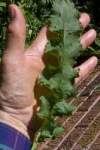 Pine Dock
Pine Dock
 Ostrich ferns and their tasty fiddleheads
Ostrich ferns and their tasty fiddleheads
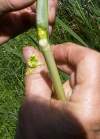 Cat-tail - Eat parts of it raw, for survival.
Cat-tail - Eat parts of it raw, for survival.
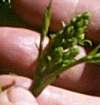 Sumac (not the poison kind) makes great lemonade!
Sumac (not the poison kind) makes great lemonade!
|
On a recent sunny, June morning, Quaal, a wild food expert, guides a hungry reporter along a nature trail he fashioned for a local historical museum. We enlist willow switches to keep the earnest mosquitos at bay, as we venture into the grocery store of nature. We won't have a feast today, for at any given time, there are only a half-dozen foods available in the wild, and darn it all, the berries won't be ready for a few weeks.
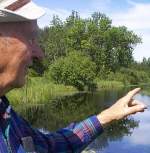 The definition of wild foods is implicit, yet sometimes bargained, but the distilling characteristic is that the plant or animal has not been refined by man. Quaal spends much of the year preparing for a 3 week period during which he and his wife, Jean, will survive on the foods. A great part of enjoying a wild food diet is gathering the food, processing it, storing and preparing it - consumption is only the final reward.
The definition of wild foods is implicit, yet sometimes bargained, but the distilling characteristic is that the plant or animal has not been refined by man. Quaal spends much of the year preparing for a 3 week period during which he and his wife, Jean, will survive on the foods. A great part of enjoying a wild food diet is gathering the food, processing it, storing and preparing it - consumption is only the final reward.
Few Americans ever eat wild foods. Though they often enjoy the refined counterparts. Farthest from the wild, are the foods which are practically cooked for you, such as the cardboard covered bricks you toss into the microwave, and eat only 5 minutes, 30 seconds later, or the manufactured snacks and desserts. More down-to-earth are the raw meats and vegetables which you buy from the produce stand and butcher - but these are far from wild.
Tomatoes, lettuce, peas, corn and most of the vegetables which are grown on a farm have been refined, grown, controlled - nearly designed - by man. They are convenient because they are grown efficiently, and they have a predictable shelf life and an appealing taste. Though Quaal eats much of these foods, he is cautious about them; "When we eat our modern diet, we go to the end of the line," he says. "What I'm doing is going back to the beginning of nourishment."
Growing up in Chisholm, Minnesota during the depression, the Quaal family would keep a venison hanging on their rear porch, the winter chill preserving it until slice, by slice, it disappeared. Unlike that deer, most meat animals we consume today are far from wild; they are fed farm-grown crops, and are controlled throughout their lives. Wild foods are ones which you will find during an average walk through a forest, just as man and woman did hundreds - even thousands - of years ago. They exist because nature put them there, and they thrive or die at the whims of nature. "Much has been gained," he says of modern foods. "But much has been lost when you alter the genetics."
Gil Quaal and Jean, his wife of 45 years, survive for three weeks each fall on wild food only, and that (for Gil Quaal at least) means, for example, not touching so much as a grain of sugar to sweeten his food, instead using maple syrup. Quaal claims this flushes out his system, as he loses a pound a day, and his cholesterol, blood pressure, triglyceride and uric acid levels dive.
Quaal doesn't survive entirely on wild food, for three reasons; time, taste and game laws. The process is inherently inefficient - it takes him forty hours to gather, process and store a week's supply of food for two people. With over 35 different plants and animals to consume, Quaal does have variety, but dishes are heavy on a few ingredients, such as wild rice (their main carbohydrate) and that can get old. "We're eating it 3 or 4 times a day, you know," says Quaal. "So when the diet spell is over, we don't even look at rice for a couple of months."
Quaal even had trouble keeping up on his wild food survival trips. In the 1970's and 1980's, he led several, popular trips to the Boundary Waters Canoe Area. Initially, he and his group would carry in no food at all, surviving for as long as one week on only the plants and animals which they could gather. But, on later trips, he would take in maple syrup and wild rice.
It's Delicious!
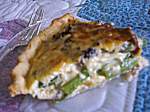 A scrumptious quiche made by Jean Quaal, for a hungry reporter. It isn't truly wild, but contains morel mushrooms and wild asparagus.
A scrumptious quiche made by Jean Quaal, for a hungry reporter. It isn't truly wild, but contains morel mushrooms and wild asparagus.
BAKED VENISON STEAK WITH CHANTERELLES
1 lb. venison steak, 1/2" thick
1 tsp. oxbow mustard
1 tsp. dried wild leeks
1 tsp. dried spikenard
1 tsp. sea salt
1 tbsp. cat-tail flour
1 tbsp. bear oil
4 oz. pre-sauteed chanterelles
2 tbsp. wild rice flour
2 dried leaflets wild bergamot
Salt, then brown meat in the bear oil. Remove meat, add water, while de-glazing. Add other ingredients to the skillet and simmer to form a thick sauce. Place meat in a casserole, cover with sauce and bake at 325 degrees for about 30 minutes. (Serves 4)
SMALL GAME
CHOP SUEY
Grouse, rabbit, duck,
or all three
Wild vegetables, i.e. ostrich fiddleheads, bulrush bases, etc.
2 cups wild rice
1 doz. leeks
Salt
Oil
Braise small pieces of meat in hot pan till dark brown. Remove and set aside. Add water and scrape pan to infuse water. Add vegetables and salt and simmer until water is absorbed. Add meat to this and set aside. Meanwhile, boil rice in water to cover until expanded. Salt to taste. Serve meat/vegetable over rice. Serves 6
|
After pointing out many edible plants (and a few poisonous ones) we stop at a creek. "The cat-tail is a marvelous reservoir of food," he says. "It is high in protein, and is available at all times of the year - it's a good survival food." Quaal picks off the stamen, which contains the pollen. "If you boil that," he says. "it has a taste somewhat like corn on the cob - not as good, but somewhat good." He says that there are a half-dozen parts of the cat-tail that are edible (not the brown flower, mind you) and much of it is full of starch. He offers me a piece and I munch on it like a rabbit - it actually tastes pretty good. "You must be hungry!" he says.
"You can't talk about Indians without talking about wild rice," Quaal says. "I think it's the only thing that enabled them to survive, because it has a lot of protein and some carbohydrates, and by a primitive technology, they could harvest it, they could process it and as long as they kept it dry, it was good and nourishing... I have some up in my attic that is 7 or 8 years old and it's still good, edible food."
The berries we miss, that grow around here, are: blueberries, raspberries, strawberries, pincherries, juneberries and gooseberries. We see some bracken fern, which is poisonous, and sumac, which isn't. Beside the trail is a soft, leafy plant called "lumberman's choice" because of its large, soft, um... absorbent, leaves. Some everyday foods we find are; wild asparagus, ostrich fern fiddleheads spikenard and milkweed pods.
After hiking the trail, we visit the Quaal home, across from the school where he taught biology and chemistry, and where he and Jean raised two daughters. "If you want to learn ecology, you go out after wild food," he says. "Because it teaches you the inter-relationship between so many things; the weather, soil types, climate and solar - all these affect what you gather." In the corner yard around the quaint, cozy home, are 27 varieties of wild plants, including wild grape and plum, so he can gauge their progress and see when they are ready to harvest. Too much rain after a plant matures will spoil it, so he may have to act quickly. "I have to watch nature all the time," he says.
 He shows me the basement, where he processes (dries, freezes and cans) his food. Jean Quaal is making mushroom quiche, and she describes the "Super Bowl," which is their favorite breakfast dish: "Grind wild rice to consistency of cream of wheat," she says. "Pour it in a bowl, make a hollow, and pour on blueberry sauce, maple syrup and hazel nuts - there's nothing better."
He shows me the basement, where he processes (dries, freezes and cans) his food. Jean Quaal is making mushroom quiche, and she describes the "Super Bowl," which is their favorite breakfast dish: "Grind wild rice to consistency of cream of wheat," she says. "Pour it in a bowl, make a hollow, and pour on blueberry sauce, maple syrup and hazel nuts - there's nothing better."
The Quaal diet provides nutrition in many ways; Carbohydrates from maple syrup, wild rice, sun chokes; protein from venison, ducks, grouse, fish, and wild rice; greens from Fern fiddleheads, milkweed pods and wild asparagus. For seasonings, he uses: ginger root, leeks, white mustard root, sea salt and even hazel nuts. Black currants found in the wild are rich in Vitamin C, he says. "Sure, we can supplement C with vitamin pills, but what other things that we don't know have we lost? What trace elements?"
It's work!
Stocking up for
3 weeks, for two people
Two decades ago, Quaal began an experiment. He prepared himself to live for one year solely on wild foods. The diet lasted for five months, when he ran out of meat and maple syrup. If you would like to consider a 3-week diet of wild foods, here are some of the items you will need.
1 deer
8 ducks
8 grouse
30 pounds fish
21 pounds wild rice
3 pounds Asparagus
2 pounds fiddleheads
2 pounds milkweed pods
8 quarts maple syrup
21 quarts berries
Teas
Spices
Wild Parsnips
|
Some animals in the Quaal diet are; walleye, perch, northern pike, frogs, turtles, crayfish, venison, ducks, grouse, and rabbits. He misses breads, which he cannot make solely from wild plants, and cabbage and Kale - "I have no substitutes for these which I can find in the wild," he says.
77 year-old Quaal left the security of his teaching career decades ago to promote the benefits of wild foods, and after years of struggling, his work has finally bore fruit. He lectures on wild foods often (even to Ojibwe Indians) he has published several booklets, and has written a book on the subject, which will go to press shortly. Before I leave for points unknown, and Quaal prepares for a trek in the woods after a batch of asparagus, he points out a similarity in our two lives; "You know, Mark, you're a lot like me," he says. "You gave up the basics of life to get to do the things you love."
So, this unusual challenge he fostered as a boy, while venturing into the Minnesota Boundary Waters, has developed into a passion, fueled by a desire to connect with nature in a wild, untamed way. It isn't the consumption of wild foods which consumes Quaal's life, but the entire approach to living off of the environment. "Some people gather money, some people gather power," he says. "Something inside of me makes me want to gather mushrooms or ferns, or whatever I can use to keep on living."